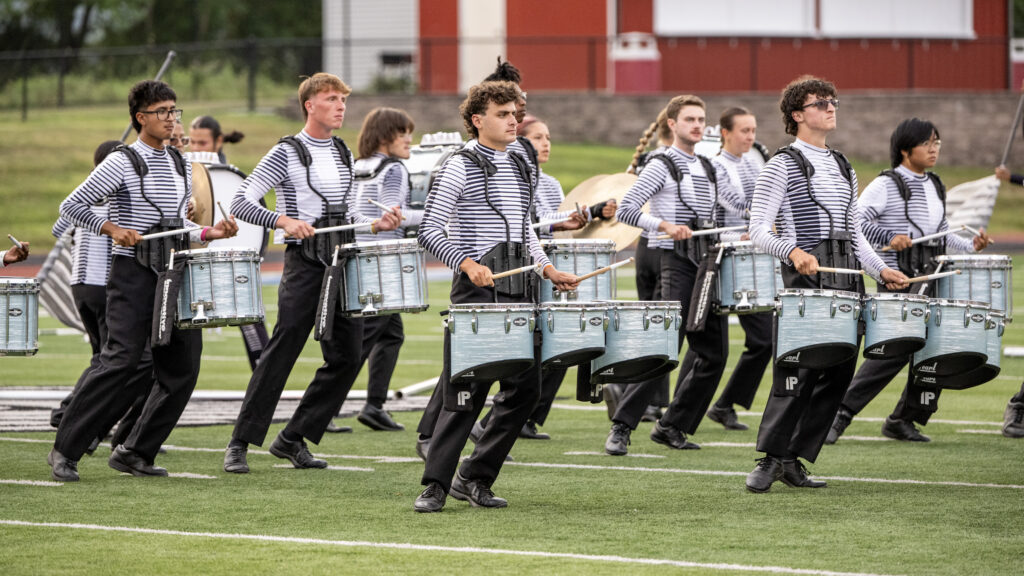Although the first Drum Corps International World Championship was held in 1972, no official video recording of the event was produced until PBS started broadcasting the Finals in 1975. Creating professional-level video recordings was not that common back then. Home video cameras were not yet marketed and professional equipment was expensive and heavy, requiring one person to hold the camera and another to hold the recorder.
There are a few professional recordings surviving from 1974, with entire shows from three corps recorded at the DCI Midwest Finals in Whitewater, Wisconsin and the three corps recorded at the DCI World Championship Prelims at Cornell University’s Schoellkopf Stadium in Ithaca, New York. The recordings from Ithaca were made for an upstate New York PBS station’s evening news. In addition, there are excerpts of seven corps from the DCI Midwest event. Unfortunately, the tape of three of the six corps recorded for the Ithaca Prelims was recorded over for later news broadcasts. Fortunately, the tape of the other three corps was spared.
Four corps made Finals for the first time in 1974, DCI’s third year, including Purple Lancers — a corps based less than 40 miles up the road from Ithaca, and presenting what would be the corps’ last performance — Blue Devils, Phantom Regiment, and DeLaSalle Oaklands, Canada’s first DCI Finalist who was about to merge with another corps to become the Oakland Crusaders.

Santa Clara Vanguard became DCI’s first back-to-back champion, with a winning score of 89.300, more than 10 points under Blue Devils’ record-high score in 2014. Back then, scores were much lower due to the tic system, where judges marked off a tenth of a point for every single error that was recorded. Theoretically, every corps started with a score of 100 when they walked onto the field, and then the judges’ pencils came out.
It was a tough year for a number of prior finalists: Blue Stars slipped to 12th place after finishing second and third the prior two seasons. Black Knights fell to 15th from a 10th-place finish in 1973, 27th Lancers slipped from 7th to 20th place, St. Andrew’s Bridgemen fell from ninth to 26th, and Argonne Rebels plummeted from 11th to 33rd.
Troopers placed sixth at the first DCI World Championship in 1972 and moved up to second in 1973.
The corps placed fifth in 1974 with a show that opened with “(Ghost) Riders in the Sky,” one of the corps’ most popular selections. Troopers had already played it in nine seasons prior to 1974 (and many years since). Subtitled “A Cowboy Legend,” the piece was written in 1948 by Stan Jones, who had earlier competed in rodeos and primarily wrote Western music. The lyrics of the song tell the story of a cowboy haunted by a vision of cattle chased across the sky by the spirits of condemned cowboys, and the melody is somewhat based on “When Johnny Comes Marching Home.”

As was customary during this time period, Troopers’ color guard utilized one set of flags for the entire show, as equipment could not be set down on the field including extra sets of flags. Troopers’ flags featured the crossed sabres emblem of the 11th Ohio Cavalry that gave the corps its name and identity. The bottom of the flags was white and the top was yellow, the color of the 11th, the corps’ scarves, and the stripes on the musicians’ trousers.
The next song in the show was a percussion feature of “Yankee Doodle,” a traditional song from the mid-1700s that may have first been sung mockingly by British troops during America’s Revolutionary War. This was the first year that mallets were allowed in competition, and at the time, only two keyboards — each carried by a performer on a harness — were allowed, one set of orchestra bells and one xylophone.
The percussion feature led into a full-corps performance of George M. Cohen’s “Yankee Doodle Dandy,” written in 1904 for the Broadway musical, “Little Johnny Jones,” which originally told the story of a jockey riding a horse named “Yankee Doodle.”
The corps settled in for its concert standstill production which featured variations on “The Yellow Rose of Texas,” a traditional song from somewhere around the mid-1800s. Some say it refers to a woman who fell in love with the President of Mexico, General Santa Ana, his preoccupation with the woman creating enough distraction to cause him to lose an important battle, and consequently, all of Texas.

After a Dixieland variation that featured members of the color guard doing a kick-step routine, those guard members faced backward and revealed yellow roses sewn on their shorts. It was a moment of levity that seemed out of character for the traditionally stoic corps.
The next selection featured Percy Faith’s “The Virginian,” written for the 1962-1971 television series of the same name that starred James Drury and Doug McClure. Faith was one of the first live radio bandleaders and also wrote for a number of singers, including Tony Bennett and Doris Day.
In the front of the field, eight rifle spinners formed a 10-yard circle around the drum major and performed the corps’ famed rifle exchange, hurtling their rifles across the circle to be caught by the person opposite them. The piece ended with the corps performing the even more famous Troopers’ trademark, the “Sunburst” exploding circle, set to the final moments of the Alfred Newman’s theme to “How the West Was Won.”
The corps’ second percussion feature was Mike Oldfield’s “Tubular Bells.” The 19-year-old Oldfield wrote all the music and played most of the instruments on the 1973 progressive rock album of the same name. It was the first album released by Richard Branson’s Virgin Records. The work achieved a spectacular amount of attention in the 1973 film, “The Exorcist.
A brief 15-second chorale of Stephen Schwartz and John-Michael Tebelak’s “Day by Day” (from the 1971 dramatic musical production of “Godspell”) led into ”Thanksgiving Prayer,” the melody of which originated as a Dutch patriotic song written by Adrianus Valerius in 1597. The melody appeared in a 1903 American hymnal, rebranded as “We Gather Together.” Since then, it has become closely associated with the Thanksgiving holiday.
The tune evolved back into “Day By Day” as the corps headed toward the back and right side of the field. This was a remnant from the previously required move of heading to the right side of the field for a “re-entry,” something all corps used to have to do at the end of their show.
A required American flag presentation was set to the melody of “Battle Hymn,” written by William Steffe around 1856, though back then the song was known as “Glory Hallelujah.” During the Civil War, Union soldiers used it as a marching song titled, “John Brown’s Body,” with lyrics memorializing the slain abolitionist. In 1861, Julia Ward Howe wrote the lyrics for “The Battle Hymn of the Republic,” using the same melody. It very well could be the single most played song ever to appear on the drum corps field, and one very much associated with Troopers.
1974 Overview

Michael Boo was a member of the Cavaliers from 1975-1977. He wrote about the drum corps activity for more than 35 years while serving as a staff writer for various Drum Corps International projects. During his lifetime Boo wrote for numerous other publications including an honors-winning book on the history of figure skating. He also was an accomplished composer. Boo passed away in 2020 and was inducted into the DCI Hall of Fame posthumously in 2021.





